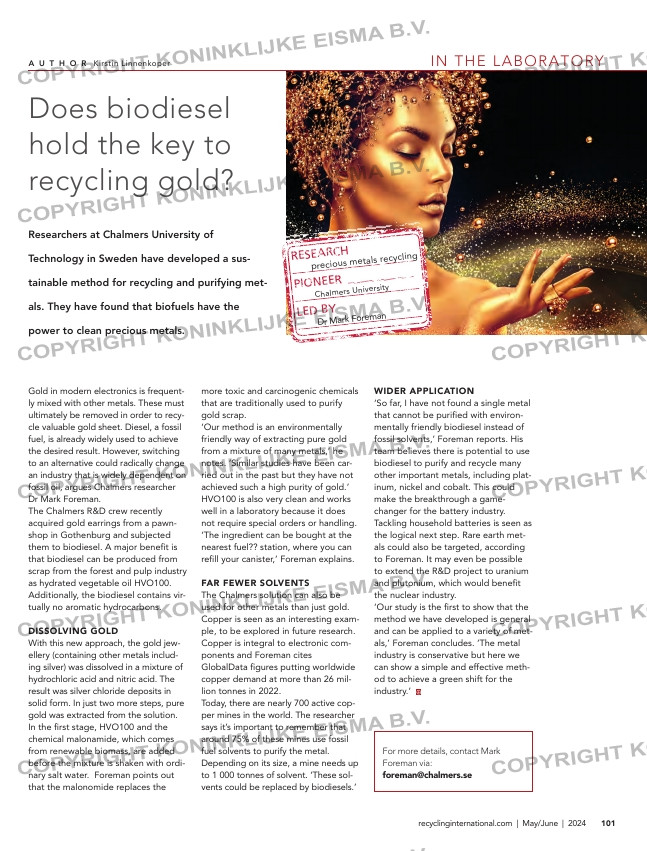Page 101 from: What’s inside?

IN THE LABORATORY
101recyclinginternational.com | May/June | 2024
Does biodiesel
hold the key to
recycling gold?
Researchers at Chalmers University of
Technology in Sweden have developed a sus-
tainable method for recycling and purifying met-
als. They have found that biofuels have the
power to clean precious metals.
Gold in modern electronics is frequent-
ly mixed with other metals. These must
ultimately be removed in order to recy-
cle valuable gold sheet. Diesel, a fossil
fuel, is already widely used to achieve
the desired result. However, switching
to an alternative could radically change
an industry that is widely dependent on
fossil oil, argues Chalmers researcher
Dr Mark Foreman.
The Chalmers R&D crew recently
acquired gold earrings from a pawn-
shop in Gothenburg and subjected
them to biodiesel. A major benefit is
that biodiesel can be produced from
scrap from the forest and pulp industry
as hydrated vegetable oil HVO100.
Additionally, the biodiesel contains vir-
tually no aromatic hydrocarbons.
DISSOLVING GOLD
With this new approach, the gold jew-
ellery (containing other metals includ-
ing silver) was dissolved in a mixture of
hydrochloric acid and nitric acid. The
result was silver chloride deposits in
solid form. In just two more steps, pure
gold was extracted from the solution.
In the first stage, HVO100 and the
chemical malonamide, which comes
from renewable biomass, are added
before the mixture is shaken with ordi-
nary salt water. Foreman points out
that the malonomide replaces the
more toxic and carcinogenic chemicals
that are traditionally used to purify
gold scrap.
‘Our method is an environmentally
friendly way of extracting pure gold
from a mixture of many metals,’ he
notes. ‘Similar studies have been car-
ried out in the past but they have not
achieved such a high purity of gold.’
HVO100 is also very clean and works
well in a laboratory because it does
not require special orders or handling.
‘The ingredient can be bought at the
nearest fuel?? station, where you can
refill your canister,’ Foreman explains.
FAR FEWER SOLVENTS
The Chalmers solution can also be
used for other metals than just gold.
Copper is seen as an interesting exam-
ple, to be explored in future research.
Copper is integral to electronic com-
ponents and Foreman cites
GlobalData figures putting worldwide
copper demand at more than 26 mil-
lion tonnes in 2022.
Today, there are nearly 700 active cop-
per mines in the world. The researcher
says it’s important to remember that
around 75% of these mines use fossil
fuel solvents to purify the metal.
Depending on its size, a mine needs up
to 1 000 tonnes of solvent. ‘These sol-
vents could be replaced by biodiesels.’
WIDER APPLICATION
‘So far, I have not found a single metal
that cannot be purified with environ-
mentally friendly biodiesel instead of
fossil solvents,’ Foreman reports. His
team believes there is potential to use
biodiesel to purify and recycle many
other important metals, including plat-
inum, nickel and cobalt. This could
make the breakthrough a game-
changer for the battery industry.
Tackling household batteries is seen as
the logical next step. Rare earth met-
als could also be targeted, according
to Foreman. It may even be possible
to extend the R&D project to uranium
and plutonium, which would benefit
the nuclear industry.
‘Our study is the first to show that the
method we have developed is general
and can be applied to a variety of met-
als,’ Foreman concludes. ‘The metal
industry is conservative but here we
can show a simple and effective meth-
od to achieve a green shift for the
industry.’
For more details, contact Mark
Foreman via:
[email protected]
A U T H O R Kirstin Linnenkoper
RESEARCH
PIONEER __
_________
LED BY
precious met
als recycling
Dr Mark Forem
an
Chalmers Uni
versity
101_inthelab.indd 101 24-04-2024 14:37



